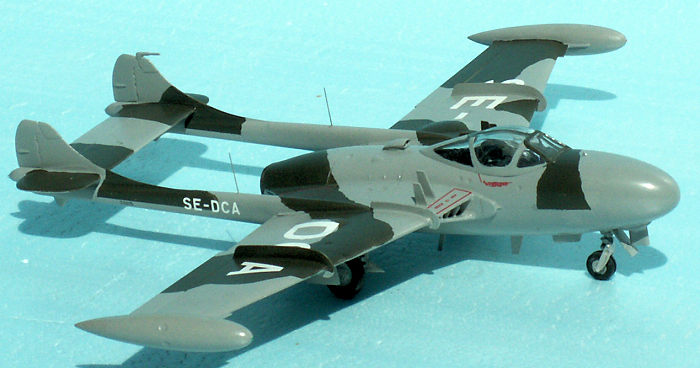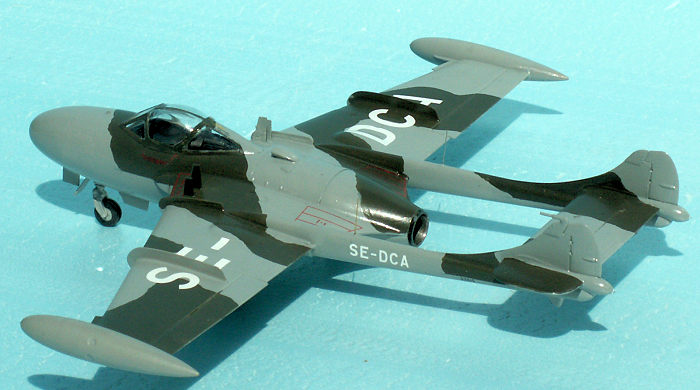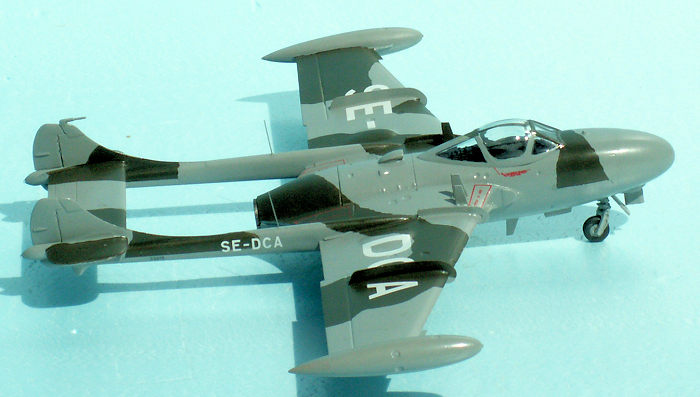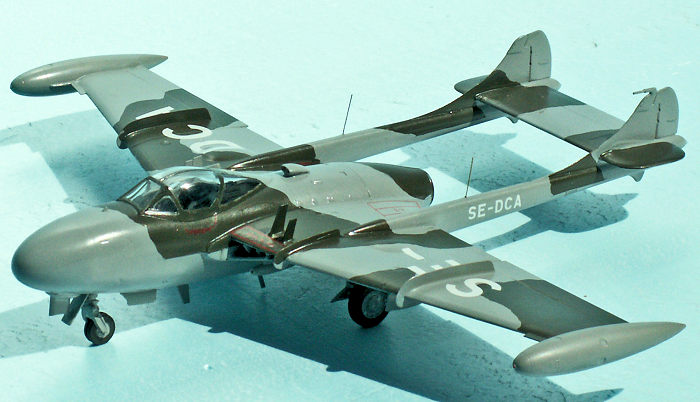
Cyber-Hobby 1/72 Venom NF.3
| KIT #: | 5116 |
| PRICE: | $20.00 |
| DECALS: | Two options |
| REVIEWER: | Torben Plesberg |
| NOTES: | Swedish civil Venom |

| HISTORY |
See
here: NOVO Sea Venom 1/72, and
here: Revell Sea Venom 1/32. The Venom was phased
out of service with the Swedish Air Force (Flygvapnet) from the beginning of
1960. The night fighter Venom was replaced by the all weather fighter J-32
Lansen. Four Venoms were sold to the Swedish Air Services (Svensk Flygtjänst),
 and got the civil registrations SE-DCA, B, D and E. In the beginning, the A and
B kept the Flygvapnet camouflage color scheme, and the civil registration
painted in white on the wings and the booms. The D and E were painted yellow
overall, the standard color scheme of Svensk Flygtjänst. Later the A and B also
got the yellow color. The registration letters were changed from white to black
to make the best contrast to the color of the planes. The subject of this model
is the SE-DCA as it first appeared with white registration letters on a full
Flygvapnet camouflage color scheme. This aircraft was damaged as it came off the
runway during a landing, piloted by Ragnar Skanaker, a well known name if you
are a dedicated handgun shooter. He won a gold medal in pistol shooting at the
Munich Olympic Games in 1972.
and got the civil registrations SE-DCA, B, D and E. In the beginning, the A and
B kept the Flygvapnet camouflage color scheme, and the civil registration
painted in white on the wings and the booms. The D and E were painted yellow
overall, the standard color scheme of Svensk Flygtjänst. Later the A and B also
got the yellow color. The registration letters were changed from white to black
to make the best contrast to the color of the planes. The subject of this model
is the SE-DCA as it first appeared with white registration letters on a full
Flygvapnet camouflage color scheme. This aircraft was damaged as it came off the
runway during a landing, piloted by Ragnar Skanaker, a well known name if you
are a dedicated handgun shooter. He won a gold medal in pistol shooting at the
Munich Olympic Games in 1972.
The SE-DCA was the first aircraft to be modified with the MTS antenna under the nose on the small hump just in front of the nose wheel. This antenna was in fact a missile tracking system for guiding the Australian Jindivik missile, of which ten examples were bought for Flygvapnet. The Venom was a well suited guiding aircraft, because its speed and flying characteristics were matching the Jindivik. The DCA survives to this day in the yellow colors of Svensk Flygtjänst and can be seen in Västerås Flygmuseum as a civil Venom TT.
| THE KIT |
In my review of the NOVO Sea Venom FAW 21 modified to a Swedish J 33 night fighter, I stated that it was the only game in town to a 1/72 scale. I later learned from the editor – and a British modeler – that another option had been released: the Cyber-hobby.com (Dragon) NF 3 Venom.
 The box
of the kit has a picture of a Swedish J 33 on the lid, and this is of course
what one might expect to get. However, is the kit in fact a model of the Swedish
J 33? The answer is no! I shall deal with all the reasons why not during the
construction. It is a nice kit and all the parts fit very well together. The
finished model is identical to the picture of the box, which is claimed to be a
Swedish J 33.
The box
of the kit has a picture of a Swedish J 33 on the lid, and this is of course
what one might expect to get. However, is the kit in fact a model of the Swedish
J 33? The answer is no! I shall deal with all the reasons why not during the
construction. It is a nice kit and all the parts fit very well together. The
finished model is identical to the picture of the box, which is claimed to be a
Swedish J 33.
The instructions is a folded sheet with six pages. Page one is a photo of the boxing lid. Besides the five sprues and the fret are shown. Pages two to four show the assembly of the kit in eight steps. There is also a color guide (Model Master color), and a guide for applying decals. The text is in Chinese, English, German, French and Italian. Pages five and six show the color schemes and decaling of the two options: RAF Sqn 125 Stradishall, and Flygvapnet F 1 Västerås.
There are four sprues in a light grey styrene. Sprue E being the two tail parts for a non navalised version of the Sea Venom. The canopy is for the Sea Venom with a raised bulb to the port to offer a better view for the pilot for a safer carrier landing. There is a PE-fret with two wing fences – there should have been four.
The quality of the decal sheet is unknown to me, since I used alternative decals for my model. However, the Swedish national roundels for the wings are far too big.
| CONSTRUCTION |
 If
you follow the instructions you will get a nice model in the end, but certainly
not a Swedish J 33 night fighter! However, the quality of the kit is far better
than the old NOVO kit, and therefore it might be easier to obtain an authentic J
33 model.
If
you follow the instructions you will get a nice model in the end, but certainly
not a Swedish J 33 night fighter! However, the quality of the kit is far better
than the old NOVO kit, and therefore it might be easier to obtain an authentic J
33 model.
In the following, I shall deal with the necessary modifications needed to create a Swedish night fighter:
The tip tanks should be symmetrical. Behind the trailing edge of the wing, I cut off the rear end of the tanks, and replaced them by new symmetrical ones, which I turned on the lathe in Ureol (artificial wood). The canopy is navalised with a bulge over the pilot’s head. This bulge I sanded away. Another flaw is the windscreen, which should be 3 mm wider. This is too big a flaw to deal with. If a NOVO canopy should be available, it would be better to use this, as the windscreen is correct in this respect!
The
lay-out of the cockpit is wrong. Most notable: the J 33 did not have ejection
seats! The nose wheel is too narrow. A disc 0.75 mm thick and with a gauge 1 mm
smaller than the wheel is positioned between the wheel halves, when these are
glued together. I modified the leg to take the broader nose wheel. The angle of
the fork must be more vertical than shown on the drawing. The length of the main
wheel legs is too long, and I cut them 3 mm shorter. If not, the aircraft will
not get the right sit on the ground. The main wheel has 10 bolts – not 12. The
same flaw as the big Sea Venom from Matchbox! However, the scale is too small to
do something ab out it. This detail + the detailed Ghost engine, show that the
Dragon people must have studied the Matchbox Venom carefully. To avoid
accusations, however, they made the pair of inspection hatches on either side of
the nose. The real thing did not have hatches looking that way! I eliminated the
hatches by filler, and sanded the sides of the nose smooth.
out it. This detail + the detailed Ghost engine, show that the
Dragon people must have studied the Matchbox Venom carefully. To avoid
accusations, however, they made the pair of inspection hatches on either side of
the nose. The real thing did not have hatches looking that way! I eliminated the
hatches by filler, and sanded the sides of the nose smooth.
The very characteristic PN-50 radar antennas and reflectors are missing with the kit. They must be scratch built from thin plastic card (0.25 mm). The fences on the underside of the tail plane is a naval thing. I simply cut and sanded them away. The night fighters have a pair of mass balances, which I made from 0.5 mm gauge brass wire + two drops of white glue. White glue is very useful, when the issue is making a wire thicker. Speaking of the tail plane, it has outboard extensions. These were made from 2 mm plastic card, sanded to get the same profile as the tail plane, and glued in place. It is important that the inner edge of the extensions conform perfectly to the tail cones of the booms. Speaking of the booms: they each have a small whip antenna, which I made from 0.2 mm brass wire.
 The wing
fences – photo-etched parts – fit remarkably well into the slots on the top side
of the wing. No glue was necessary to fix them. The paint will do the fixing.
There are two more smaller fences just in front of the booms. They were made
from 0.25 mm plastic card. The small hump under the nose was missing. It was
made of a small piece of Ureol. The Jindivik tracking device is fastened to this
hump. This antenna was made of 0.75 mm plastic card.
The wing
fences – photo-etched parts – fit remarkably well into the slots on the top side
of the wing. No glue was necessary to fix them. The paint will do the fixing.
There are two more smaller fences just in front of the booms. They were made
from 0.25 mm plastic card. The small hump under the nose was missing. It was
made of a small piece of Ureol. The Jindivik tracking device is fastened to this
hump. This antenna was made of 0.75 mm plastic card.
The new sprue E, which was added to the Sea Venom kit, just to make the night fighter Venom, is not correct. The exhaust opening is far too large, and not long enough. That is a serious flaw of the kit. The NOVO kit is actually better in this respect, because it is entirely up to you to make a new rear end of the kit! I did not do anything about it. It was, however not an easy job to cut away the Sea Venom rear fuselage and replace it with the night fighter rear fuselage from sprue E. Probably, the too thick and too short rear end has something to do with the detailed Ghost engine to be built in. I remember from the Matchbox kit, that it was not possible for me to glue the fuselage properly together with the Ghost engine inside. Therefore, I made a workshop dolly to show the Ghost engine built out of the aircraft. Since I already had the large Ghost engine to a 1/32 scale, it was uninteresting to assemble the small 1/72 Ghost engine. The 1/72 Dragon Ghost engine is made exactly equal to the Matchbox Ghost engine – only smaller!
| COLORS & MARKINGS |
 The
standard color scheme of a Swedish J 33 is all over Medium Sea Grey (Xtra Color
X 3 or HB 165) and with a camouflage pattern on the upper sides of Dark Green (Xtra
Color X 110 or HB 163). If the model should be a standard Flygvapnet night
fighter, I would have to apply some smaller gauge national markings from Flying
Colors. These supplied with the kit for the wings are far too large. However, I
had the necessary civil markings: SE-DCA from a Maestro Sheet MMD7209 J 33
Venom, which I purchased for my NOVO Venom model. This sheet is highly
recommendable for Swedish Venoms – military or civil.
The
standard color scheme of a Swedish J 33 is all over Medium Sea Grey (Xtra Color
X 3 or HB 165) and with a camouflage pattern on the upper sides of Dark Green (Xtra
Color X 110 or HB 163). If the model should be a standard Flygvapnet night
fighter, I would have to apply some smaller gauge national markings from Flying
Colors. These supplied with the kit for the wings are far too large. However, I
had the necessary civil markings: SE-DCA from a Maestro Sheet MMD7209 J 33
Venom, which I purchased for my NOVO Venom model. This sheet is highly
recommendable for Swedish Venoms – military or civil.
The last details added were the incredibly small lights in the rear end of the booms. They are smaller than one mm, and impossible to handle by hand or even by a pair of tweezers. I had actually given up to place them on the model. Then I remembered the glue-stix – and this wonder tool was able to pick up the lights and place the pins of the lights into the 0.3 mm gauge holes in the ends of the booms.
| CONCLUSIONS |
Cyber-hobby (Dragon) has produced a well engineered kit of remarkable precision. Everything fits perfectly together, and in this respect, the kit is highly recommendable to all modelers. However, Dragon did not do their research properly, and the model claimed to be a Swedish night fighter, is not such a thing! It takes a lot of scratch-building and modifications to create a Swedish night fighter from this kit. In this respect, the kit is not recommendable. I would say: it is a real challenge, to make a J 33 from this kit.
| REFERENCES |
Mikael Forslund: J 33 Venom NF 51. Allt om Hobby. ISBN 91-85496 -43-X. This is the book on the J 33 Venom, and with a summary in English (twenty pages). The author even gives a very good description of, how he built the Matchbox 1/32 Venom.
28 October 2019
Copyright ModelingMadness.com
If you would like your product reviewed fairly and fairly quickly, please contact the editor or see other details in the Note to Contributors.
Back to the Main Page Back to the Review Index Page Back to the Previews Index Page